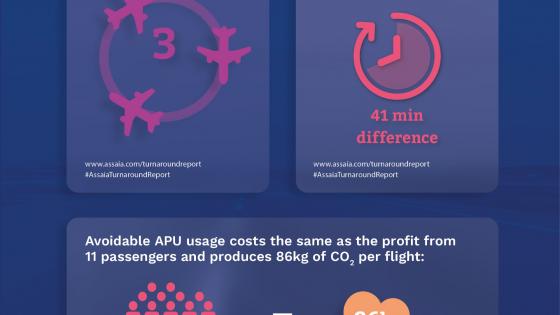Assaia, a specialist in AI-enabled turnaround management, has published its inaugural Turnaround Benchmark Report, analysing how turnarounds affect airport and airline performance.
According to Switzerland-based Assaia, three important findings from the Turnaround Benchmark Report clearly demonstrate the importance of holistic turnaround monitoring and management:
- The 41-minute difference between the best and worst turnaround performances, potentially costing airlines and airports billions of dollars a year and delaying passengers
- The ability of the best performing airlines and airports to deliver three more turnarounds per day than the worst performers
- Avoidable APU (auxiliary power unit) usage, which costs the same as the profit from 11 passengers and produces 86kg of CO2 per flight.
Airlines and airports need to find all the efficiencies they can
Max Diez, Assaia CEO, said, “We all know the industry operates on wafer-thin margins. Fuel prices are currently going up, which makes everyone nervous. And just in the past few weeks, we’ve seen disruption and delays caused by technology outages, bad weather, infrastructure failures, industrial action and staffing issues.
“Airlines and airports need to find all the efficiencies they can. Every aspect of airport and airline operations is monitored and managed to the highest degree. The exception, until very recently, has been the turnaround. Because it is made up of many activities performed by multiple entities, it has been very difficult to get a complete picture of the entire operation. And without measurement, effective management is impossible.

The Turnaround Benchmark Report demonstrated the importance of holistic turnaround management
The Turnaround Benchmark Report provides information on on-time performance, the efficiency of catering, fuelling, unloading and loading, and pushback connections. It also examines the environmental implications of turnaround operations, focusing on auxiliary power unit and pre-conditioned air usage. Short-haul flights are the focus of this first report, because inefficient turnarounds can have a bigger impact by leading to cancelled flights and frustrated passengers at the end of the day.
Diez concluded, “The results are based on analysis of the worst-performing third, the middle performing third and the best-performing third. The differences between the best and worst performers demonstrate very clearly why monitoring and holistic management of turnarounds is so important.”
Assaia applies Artificial Intelligence Computer Vision technology to provide airports and airlines with complete visibility of turnaround operations. The resulting automated monitoring delivers complete visibility of the hundreds of tasks carried out by scores of people at the turnaround. This enables airports, airlines and ground handlers to free up gates faster, increasing efficiency, reducing delays, improving safety and cutting CO2 emissions.
Image: Assaia
